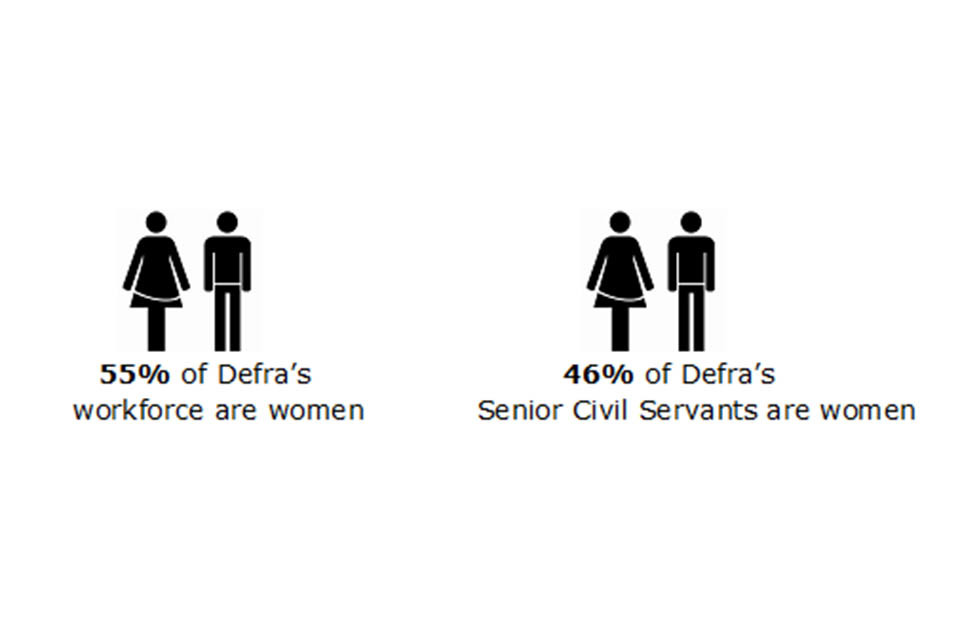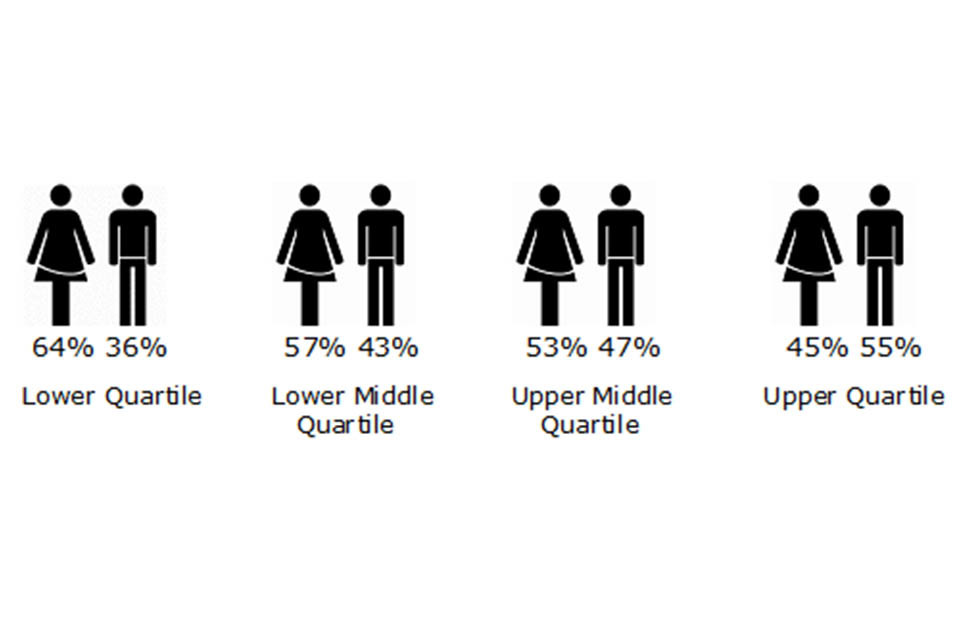Defra's gender pay gap report 2018
Published 19 December 2018
Introduction
In 2017, the government introduced world-leading legislation that made it statutory for organisations with 250 or more employees to report annually on their gender pay gap. Government departments are covered by the Equality Act 2010 (Specific Duties and Public Authorities) Regulations 2017 which came into force on 31 March 2017. These regulations underpin the Public Sector Equality Duty and require relevant organisations to publish their gender pay gap by 30 March annually. This includes the mean and median gender pay gaps; the mean and median gender bonus gaps; the proportion of men and women who received bonuses; and the proportions of male and female employees in each pay quartile.
The gender pay gap shows the difference in the average pay between all men and women in a workforce. If a workforce has a particularly high gender pay gap, this can indicate there may be a number of issues to deal with, and the individual calculations may help to identify what those issues are.
The gender pay gap is different to equal pay. Equal pay deals with the pay differences between men and women who carry out the same jobs, similar jobs or work of equal value. It is unlawful to pay people unequally because they are a man or a woman. Defra supports the fair treatment and reward of all staff irrespective of gender.
Building a diverse and inclusive workforce that reflects the people we serve is one of the Civil Service’s top workforce priorities. Our collective aim is to make the Civil Service the UK’s most inclusive employer by 2020. The Civil Service should create opportunities for all in a truly meritocratic way and reward all civil servants fairly, regardless of gender, ethnicity or any other personal characteristic
This report fulfils Defra’s reporting requirements, analyses the figures in more detail and sets out what we have done to reduce the gender pay gap.
Gender make-up of the department

Image showing gender make-up of the department. 55% of Defra's workforce are women. 46% of Defra's SCS are women
There has been an increase of 1% and 3% respectively on the 2017 figures where 54% of the workforce were women and 43% of Defra’s Senior Civil Service posts were held by women.
The following table which shows the distribution of female and male staff by grade from junior roles to senior roles in Defra. Women are over-represented in more junior grades, where pay is lower, and under-represented in more senior grades.
| Grade (increasing seniority) | Number of men (% of men who work in this grade) | Number of women (% of women who work in this grade) | % female |
|---|---|---|---|
| AA/AO | 560 (15%) | 1,040 (23%) | 65% |
| EO | 732 (20%) | 964 (22%) | 57% |
| HEO/SEO | 1,504 (41%) | 1,716 (39%) | 53% |
| Grade 6/7 | 791 (22%) | 656 (15%) | 45% |
| SCS (centrally managed only) | 74 (2%) | 63 (1%) | 46% |
| Total (including those with unknown grade) | 3,661 | 4,439 | 55% |
In comparison, this table shows the proportion of men and women at each grade in the Civil Service overall:
| Grade (increasing seniority) | Number of men (% of men who work in this grade) | Number of women (% of women who work in this grade) | % female |
|---|---|---|---|
| AA/AO | 623,465 (32%) | 84,814 (37%) | 57% |
| EO | 47,806 (24%) | 62,295 (27%) | 57% |
| HEO/SEO | 53,705 (27%) | 52,442 (23%) | 49% |
| Grade 6/7 | 24,500 (12%) | 21,110 (9%) | 46% |
| SCS (centrally managed only) | 2,598 (2%) | 1,973 (1%) | 43% |
| Total (including those with unknown grade) | 198,420 | 231,655 | 54% |
Defra gender pay gap

Image showing the mean (9.8%) and median (11.7%) pay gap
Defra uses Civil Service grades ranging from Administrative Assistants (admin level grade) to Senior Civil Servant (executive level grade). Grades vary according to the level of responsibility that staff have. Each grade has a set pay range with pay gaps in between grades. Staff are expected to move through the pay range for their grade, therefore the longer period of time that someone has been in a grade the more we would expect them to earn irrespective of their gender.
The mean gender pay gap has reduced by 1.7% from 2017 when it stood at 11.5% higher for males than females. The median gender pay gap has also reduced, by 0.4% from the 2017 figure of 12.1%.
Defra has done a significant amount of recruitment as preparations for EU exit get underway. The recruitment figures show that there were more high paying females who were hired and that helped to reduce the gender pay gap.
Bonus pay gap

Image showing the mean (10%), median (19%) of bonus pay gap. Also shows proportion of men (35%) and women (39%) receiving bonus
The mean bonus pay gap has reduced by 10.6% (down from 20.6%) in 2017 and the median gender pay gap has risen slightly by 2.3% to 19% which is up from 16.7% in 2017.
The proportion of both men and women receiving bonuses has reduced since 2017 by 8% and 10% respectively.
Defra’s performance awards were paid as a set value depending on grade and performance level, irrespective of gender. Bonuses were pro-rated for staff who worked part-time.
Pay by quartiles
Hourly pay quartiles

Image showing pay by quartiles
The lower quartile of staff remains the same as in 2017 at 64% female staff and 36% male staff however the upper middle and the upper quartile have both seen a rise of 3% and 2% respectively in female staff.
As 55% of the department’s staff are women, this illustrates that the pay gap is largely as a result of a higher concentration of women in more junior grades and fewer female staff in more senior grades.
There has been an increase in female staff in Defra since 2017 and an increase in women in the upper pay quartiles.
Working to reduce the Gender Pay Gap
Defra is committed to supporting the Civil Service Diversity and Inclusion Strategy which sets out how we will become the most inclusive employer in the UK by 2020.
We are improving our gender pay gap and delivering a number of initiatives to support women in the workplace through our Defra group Equality, Diversity and Inclusion strategy:
Active support for women returning to work following maternity or adoption leave. We offer shared parental leave, job share, part-time opportunities and flexible working. We equally offer these opportunities to men to enable all employees to fulfil their caring responsibilities irrespective of gender.
We help women to progress their careers through schemes such as the Positive Action Pathway (a talent programme for under-represented groups) and Crossing Thresholds (a year-long career development programme for Women in the Civil Service). We encourage participation in talent programmes supporting the right people into the right roles providing access to the right opportunities, exposure, stretch and development to reach their potential. These include, Future Leaders Scheme, Senior Leaders Scheme, Civil Service Fast Stream, and Apprenticeships.
We provide a range of employee led networks supported and championed by Defra’s senior management and Equality and Diversity and Inclusion teams. Defra’s women’s network aims to help women reach their full potential by providing advice and support, contributing to policy development and establishing good practices.
In addition to the Women’s network Defra also has a Job Share Network, Parental Leave Buddy Network and a Work Life Balance Network. We are now looking to support the set-up of a returning parents network to encourage and support the return to work.
We monitor pay to identify any pay differences and take targeted action, where appropriate and where budget constraints allow.
We have improved the recruitment process through anonymised application processes and using diverse interview panels for selection. Recruitment data is monitored through the attraction, recruitment and selection process to identify areas for further improvement in recruiting a diverse workforce.
Declaration
We confirm that data reported by Defra is accurate and has been calculated according to the requirements and methodology set out in the Equality Act 2010 (Specific Duties and Public Authorities) Regulations 2017.
Defra Permanent Secretary: Clare Moriarty
